Compatible Lenses
Compatible CPU Lenses
This camera supports autofocus with AF-P and type E and G AF-S lenses only. AF-S lenses have names beginning with AF-S and AF-P lenses with AF-P; for information on determining lens type (D, E, G, or CPU), see “Identifying CPU and Type G, E, and D Lenses” (0 Identifying CPU and Type G, E, and D Lenses). Autofocus is not supported with other autofocus (AF) lenses. The following table lists the features available with compatible lenses in viewfinder photography:
|
Camera setting Lens 1 |
Focus mode | Shooting mode |
Metering system |
||||
|---|---|---|---|---|---|---|---|
| AF | MF (with electronic rangefinder) |
MF | M | Other modes |
L |
M N |
|
| E type lens | 2 | ||||||
| Type G AF-S/AF-P NIKKOR | 2 | ||||||
| Type G AF NIKKOR | — | 2 | |||||
| D type lens | — | 3 | — | — | — | ||
| PC-E NIKKOR series 4, 5 | — | 6 | 2 | ||||
| PC Micro 85mm f/2.8D 7 | — | 6 | 3 | — | 2 | ||
| Other AF NIKKOR (except lenses for F3AF) |
— | 8 | 3 | — | — | — | |
| AI-P NIKKOR | — | 9 | 3 | — | — | — | |
Assumes a combined aperture of f/5.6 or faster when AF-S teleconverter is attached.
Spot metering meters selected focus point (0 Spot metering).
Exposure indicator disabled.
The shift knob for the PC-E NIKKOR 24mm f/3.5D ED may contact the camera body when the lens is revolved.
Shifting and/or tilting the lens interferes with exposure.
Cannot be used with shifting or tilting.
Optimal exposure will only be achieved if the lens is at maximum aperture and the lens is not shifted or tilted.
When AF 80–200mm f/2.8, AF 35–70mm f/2.8, AF 28–85mm f/3.5–4.5 (New), or AF 28–85mm f/3.5–4.5 lenses are zoomed all the way in at the minimum focus distance, the in-focus indicator (I) may be displayed when the image on the matte screen in the viewfinder is not in focus. Before shooting, confirm that the image in the viewfinder screen is in focus.
With maximum aperture of f/5.6 or faster.
Noise in the form of lines may appear during autofocus when movies are recorded at high ISO sensitivities. Use manual focus or focus lock.
IX NIKKOR Lenses
IX NIKKOR lenses cannot be used. Attempting to attach an IX NIKKOR lens could damage the lens or camera.
Identifying CPU and Type G, E, and D Lenses
CPU lenses can be identified by the presence of CPU contacts, type G, E, and D lenses by a letter on the lens barrel. Type G and E lenses are not equipped with a lens aperture ring.
CPU contacts
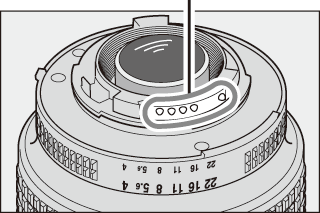
CPU lens
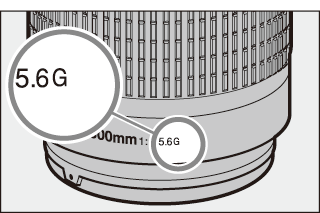
Type G or E lens
Aperture ring
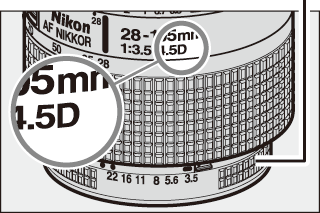
Type D lens
Type D Lenses
Type D lenses may only be used when the camera is in mode M. Selecting another mode disables the shutter release. Aperture must be adjusted manually via the lens aperture ring and the camera metering system and i-TTL flash control cannot be used.
Compatible Non-CPU Lenses
Non-CPU lenses may only be used when the camera is in mode M. Selecting another mode disables the shutter release. Aperture must be adjusted manually via the lens aperture ring and the camera metering system, i-TTL flash control, and other features requiring a CPU lens cannot be used. Some non-CPU lenses cannot be used; see “Incompatible Accessories and Non-CPU Lenses,” below.
|
Camera setting Lens/accessory |
Focus | Mode | |||
|---|---|---|---|---|---|
| AF | MF (with electronic rangefinder) |
MF | M | Other modes |
|
| AI-, AI-modified NIKKOR or Nikon Series E lenses |
— | 1 | 2 | — | |
| Medical NIKKOR 120mm f/4 | — | 3 | — | ||
| Reflex NIKKOR | — | — | 2 | — | |
| PC NIKKOR | — | 4 | 2 | — | |
| AI-type Teleconverter | — | 5 | 2 | — | |
| PB-6 Bellows Focusing Attachment 6 | — | 1 | 2 | — | |
| Auto extension rings (PK-series 11A, 12, or 13; PN-11) |
— | 1 | 2 | — | |
With maximum aperture of f/5.6 or faster.
Exposure indicator cannot be used.
Can be used at shutter speeds slower than flash sync speed by one step or more.
Cannot be used with shifting or tilting.
With maximum effective aperture of f/5.6 or faster.
Attach in vertical orientation (can be used in horizontal orientation once attached).
Incompatible Accessories and Non-CPU Lenses
The following accessories and non-CPU lenses cannot be used with the D3500:
- TC-16A AF teleconverter
- Non-AI lenses
- Lenses that require the AU-1 focusing unit (400mm f/4.5, 600mm f/5.6, 800mm f/8, 1200mm f/11)
- Fisheye (6mm f/5.6, 7.5mm f/5.6, 8mm f/8, OP 10mm f/5.6)
- 2.1cm f/4
- Extension Ring K2
- 180–600mm f/8 ED (serial numbers 174041–174180)
- 360–1200mm f/11 ED (serial numbers 174031–174127)
- 200–600mm f/9.5 (serial numbers 280001–300490)
- AF lenses for the F3AF (AF 80mm f/2.8, AF 200mm f/3.5 ED, AF Teleconverter TC-16)
- PC 28mm f/4 (serial number 180900 or earlier)
- PC 35mm f/2.8 (serial numbers 851001–906200)
- PC 35mm f/3.5 (old type)
- Reflex 1000mm f/6.3 (old type)
- Reflex 1000mm f/11 (serial numbers 142361–143000)
- Reflex 2000mm f/11 (serial numbers 200111–200310)
AF-Assist Illumination
The AF-assist illuminator has a range of about 0.5–3.0 m (1 ft 8 in.–9 ft 10 in.); when using the illuminator, use a lens with a focal length of 18–200 mm and remove the lens hood. AF-assist illumination is not available with the following lenses:
- AF-S NIKKOR 14–24mm f/2.8G ED
- AF-S NIKKOR 28–300mm f/3.5–5.6G ED VR
- AF-S DX NIKKOR 55–300mm f/4.5–5.6G ED VR
- AF-S VR Zoom-Nikkor 70–200mm f/2.8G IF-ED
- AF-S NIKKOR 70–200mm f/2.8G ED VR II
- AF-S Zoom-Nikkor 80–200mm f/2.8D IF-ED
- AF-S NIKKOR 80–400mm f/4.5–5.6G ED VR
- AF-S NIKKOR 180–400mm f/4E TC1.4 FL ED VR
- AF-S VR Nikkor 200mm f/2G IF-ED
- AF-S NIKKOR 200mm f/2G ED VR II
- AF-S VR Zoom-Nikkor 200–400mm f/4G IF-ED
- AF-S NIKKOR 200–400mm f/4G ED VR II
- AF-S NIKKOR 200–500mm f/5.6E ED VR
At ranges under 1 m (3 ft 3 in.), the following lenses may block the AF-assist illuminator and interfere with autofocus when lighting is poor:
- AF-S DX NIKKOR 10–24mm f/3.5–4.5G ED
- AF-S NIKKOR 16–35mm f/4G ED VR
- AF-S Zoom-Nikkor 17–35mm f/2.8D IF-ED
- AF-S DX Zoom-Nikkor 17–55mm f/2.8G IF-ED
- AF-S DX NIKKOR 18–105mm f/3.5–5.6G ED VR
- AF-S DX VR Zoom-Nikkor 18–200mm f/3.5–5.6G IF-ED
- AF-S DX NIKKOR 18–200mm f/3.5–5.6G ED VR II
- AF-S DX NIKKOR 18–300mm f/3.5–5.6G ED VR
- AF-S DX NIKKOR 18–300mm f/3.5–6.3G ED VR
- AF-S NIKKOR 20mm f/1.8G ED
- AF-S NIKKOR 24–70mm f/2.8G ED
- AF-S NIKKOR 24–70mm f/2.8E ED VR
- AF-S VR Zoom-Nikkor 24–120mm f/3.5–5.6G IF-ED
- AF-S NIKKOR 24–120mm f/4G ED VR
- AF-S NIKKOR 28mm f/1.4E ED
- AF-S NIKKOR 28mm f/1.8G
- AF-S Zoom-Nikkor 28–70mm f/2.8D IF-ED
- AF-S NIKKOR 35mm f/1.4G
- AF-S NIKKOR 70–200mm f/4G ED VR
- AF-S NIKKOR 70–200mm f/4G ED
- AF-P DX NIKKOR 70–300mm f/4.5–6.3G ED VR
- AF-P DX NIKKOR 70–300mm f/4.5–6.3G ED
- AF-S NIKKOR 85mm f/1.4G
- AF-S NIKKOR 85mm f/1.8G
- AF-S VR Micro-Nikkor 105mm f/2.8G IF-ED
The Built-in Flash
The built-in flash can be used with lenses with focal lengths of 18–300 mm, although in some cases the flash may be unable to entirely light the subject at some ranges or focal lengths due to shadows cast by the lens (see the illustration below), while lenses that block the subject’s view of the red-eye reduction lamp may interfere with red-eye reduction. Remove lens hoods to prevent shadows.
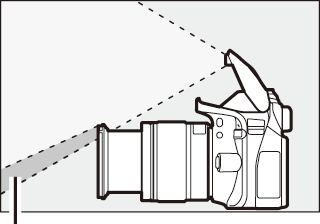
Shadow

Vignetting
The flash has a minimum range of 0.6 m and cannot be used in the macro range of macro zoom lenses. The flash may be unable to light the entire subject with the following lenses at ranges less than those given below:
| Lens | Zoom position (focal length) | Minimum distance without vignetting |
|---|---|---|
| AF-S DX NIKKOR 10–24mm f/3.5–4.5G ED | 24 mm | 1.5 m / 5 ft |
| AF-S DX Zoom-Nikkor 12–24mm f/4G IF-ED | 24 mm | 1.0 m / 3 ft 4 in. |
| AF-S NIKKOR 16–35mm f/4G ED VR | 35 mm | 1.0 m / 3 ft 4 in. |
| AF-S DX NIKKOR 16–80mm f/2.8–4E ED VR | 24 mm | 1.0 m / 3 ft 4 in. |
| 35–80 mm | No vignetting | |
| AF-S DX NIKKOR 16–85mm f/3.5–5.6G ED VR | 24–85 mm | No vignetting |
| AF-S Zoom-Nikkor 17–35mm f/2.8D IF-ED | 28 mm | 1.0 m / 3 ft 4 in. |
| 35 mm | No vignetting | |
| AF-S DX Zoom-Nikkor 17–55mm f/2.8G IF-ED | 28 mm | 1.5 m / 5 ft |
| 35 mm | 1.0 m / 3 ft 4 in. | |
| 45–55 mm | No vignetting | |
| AF-S NIKKOR 18–35mm f/3.5–4.5G ED | 24 mm | 1.5 m / 5 ft |
| 28–35 mm | No vignetting | |
| AF Zoom-Nikkor 18–35mm f/3.5–4.5D IF-ED | 24 mm | 1.0 m / 3 ft 4 in. |
| 28–35 mm | No vignetting | |
| AF-P DX NIKKOR 18–55mm f/3.5–5.6G VR, AF-P DX NIKKOR 18–55mm f/3.5–5.6G | 18 mm | 1.0 m / 3 ft 4 in. |
| 24–55 mm | No vignetting | |
| AF-S DX Zoom-Nikkor 18–70mm f/3.5–4.5G IF-ED | 18 mm | 1.0 m / 3 ft 4 in. |
| 24–70 mm | No vignetting | |
| AF-S DX NIKKOR 18–105mm f/3.5–5.6G ED VR | 18 mm | 2.5 m / 8 ft 3 in. |
| 24 mm | 1.0 m / 3 ft 4 in. | |
| 35–105 mm | No vignetting | |
| AF-S DX Zoom-Nikkor 18–135mm f/3.5–5.6G IF-ED | 18 mm | 2.0 m / 6 ft 7 in. |
| 24–135 mm | No vignetting | |
| AF-S DX NIKKOR 18–140mm f/3.5–5.6G ED VR | 24 mm | 1.0 m / 3 ft 4 in. |
| 35–140 mm | No vignetting | |
| AF-S DX VR Zoom-Nikkor 18–200mm f/3.5–5.6G IF-ED, AF-S DX NIKKOR 18–200mm f/3.5–5.6G ED VR II | 24 mm | 1.0 m / 3 ft 4 in. |
| 35–200 mm | No vignetting | |
| AF-S DX NIKKOR 18–300mm f/3.5–5.6G ED VR | 35 mm | 1.5 m/ 5 ft |
| 50 mm | 1.0 m / 3 ft 4 in. | |
| 105–300 mm | No vignetting | |
| AF-S NIKKOR 20mm f/1.8G ED | 20 mm | 1.5 m/ 5 ft |
| AF Zoom-Nikkor 20–35mm f/2.8D IF | 24 mm | 2.5 m / 8 ft 3 in. |
| 28 mm | 1.0 m / 3 ft 4 in. | |
| 35 mm | No vignetting | |
| AF-S NIKKOR 24mm f/1.4G ED | 24 mm | 1.0 m / 3 ft 4 in. |
| AF-S NIKKOR 24–70mm f/2.8G ED | 35 mm | 1.5 m / 5 ft |
| 50–70 mm | No vignetting | |
| AF-S NIKKOR 24–70mm f/2.8E ED VR | 50 mm | 1.0 m / 3 ft 4 in. |
| 70 mm | No vignetting | |
| AF-S VR Zoom-Nikkor 24–120mm f/3.5–5.6G IF-ED | 24 mm | 1.0 m / 3 ft 4 in. |
| 28–120 mm | No vignetting | |
| AF-S NIKKOR 24–120mm f/4G ED VR | 24 mm | 1.5 m / 5 ft |
| 28 mm | 1.0 m / 3 ft 4 in. | |
| 35–120 mm | No vignetting | |
| AF-S NIKKOR 28mm f/1.4E ED | 28 mm | 1.0 m / 3 ft 4 in. |
| AF-S Zoom-Nikkor 28–70mm f/2.8D IF-ED | 35 mm | 1.5 m / 5 ft |
| 50–70 mm | No vignetting | |
| AF-S NIKKOR 28–300mm f/3.5–5.6G ED VR | 28 mm | 1.5 m / 5 ft |
| 35 mm | 1.0 m / 3 ft 4 in. | |
| 50–300 mm | No vignetting | |
| AF-S NIKKOR 180–400mm f/4E TC1.4 FL ED VR | Built-in teleconverter disabled: | |
| 250 mm | 3.0 m/9 ft 11 in. | |
| 300 mm | 2.5 m/8 ft 3 in. | |
| Built-in teleconverter enabled: | ||
| 180 mm (252 mm) | 3.0 m / 9 ft 11 in. | |
| 200 mm (280 mm) | 3.0 m / 9 ft 11 in. | |
| AF-S VR Zoom-Nikkor 200–400mm f/4G IF-ED, AF-S NIKKOR 200–400mm f/4G ED VR II | 200 mm | 4.0 m/ 13 ft 2 in. |
| 250 mm | 3.0 m / 9 ft 11 in. | |
| 300 mm | 2.5 m/8 ft 3 in. | |
| PC-E NIKKOR 24mm f/3.5D ED * | 24 mm | 3.0 m / 9 ft 11 in. |
When not shifted or tilted.
When used with the AF-S NIKKOR 14–24mm f/2.8G ED, the flash will be unable to light the entire subject at all ranges.
Calculating Angle of View
The size of the area exposed by a 35 mm camera is 36 × 24 mm. The size of the area exposed by the D3500, in contrast, is 23.5 × 15.6 mm, meaning that the angle of view of a 35 mm camera is approximately 1.5 times that of the D3500. The approximate focal length of lenses for the D3500 in 35 mm format can be calculated by multiplying the focal length of the lens by about 1.5.
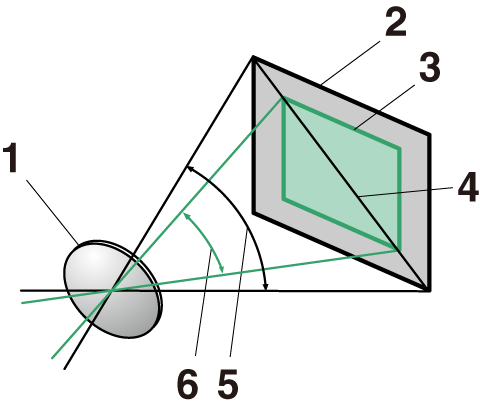
| 1 | Lens |
|---|---|
| 2 | Picture size (35 mm format) (36 × 24 mm) |
| 3 | Picture size (D3500) (23.5 × 15.6 mm) |
| 4 | Picture diagonal |
| 5 | Angle of view (35 mm format) |
| 6 | Angle of view (D3500) |
